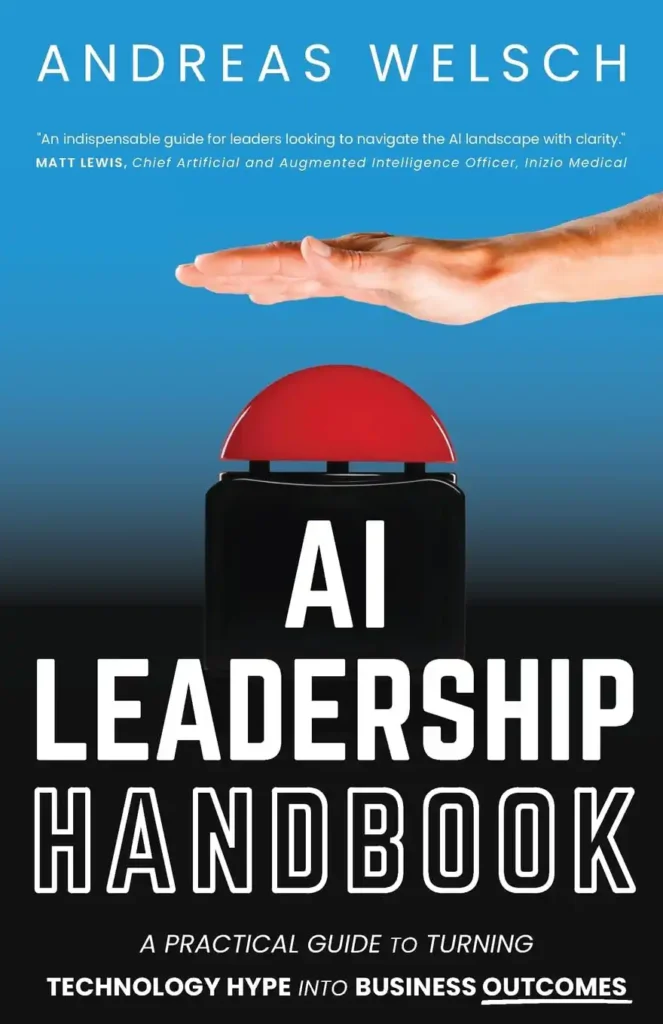
Artificial intelligence is reshaping industries, but technology alone isn’t enough. Many AI initiatives fall short not because of weak models or missing data, but due to poor leadership and lack of clear direction.
AI Leadership Handbook (affiliate link) by Andreas Welsch, a recognized AI leader and advisor, is a practical, real-world guide for those looking to unlock the full value of AI. The book introduces nine essential dimensions that successful organizations manage together, including strategy, culture, governance, ethics, and change management.
If you’re leading or supporting AI in any part of your organization, these nine dimensions can help you avoid costly missteps and lead with structure, clarity, and long-term impact.
New to AI? Start with AI Fundamentals: A Beginner’s Guide to Artificial Intelligence
Inside the AI Leadership Handbook: The 9 Dimensions That Drive Results
The AI Leadership Handbook outlines nine essential areas that every successful AI initiative must address. It is organized into three key parts: leadership foundations, organizational readiness, and responsible implementation. These dimensions help leaders connect strategy, people, technology, and accountability in a way that delivers measurable business value.
1. Recognizing What Drives AI Hype and Momentum
Many organizations feel pressure to move quickly with AI due to trends, media buzz, and fear of missing out (FOMO). But starting without a clear purpose often leads to poor results.
The book reflects on the history of AI hype cycles and explains why this wave is different. Generative AI stands out because it is more accessible, higher in quality, and easier to scale across industries.
Leaders are reminded to look past the excitement and focus on long-term impact, including how AI may affect jobs and reshape economies. Understanding these forces helps guide smarter, more grounded decisions.
2. Aligning AI with Business Strategy
For AI to create value, it must support a clear business goal. That means starting with the problem first and choosing the right approach, whether it’s machine learning, generative AI, or basic automation.
The book introduces four levels of automation: limited automation, advanced automation, limited autonomy, and advanced autonomy. Choosing the right level depends on your goals and available resources. Once a strategy is selected, the next step is to put it into practice.
Even with the excitement around AI, basic management principles still apply. AI must align with your strategy and adjust as market conditions change. It is one of many tools that can help your business stay relevant.
3. Taking Ownership as an AI Leader
AI needs clear ownership to succeed. Unlike traditional roles such as Chief Information Officer (CIO) or Chief Technology Officer (CTO), most businesses have only recently started assigning leadership for AI. That is now changing with the rise of the Chief AI Officer (CAIO), a role focused on four areas: knowledge, enablement, governance, and vision.
Strong AI leadership also means setting realistic goals. Many companies want to transform operations but often overlook the need to match the right technology to the right business problem. Understanding the strengths of different AI methods is essential when choosing the right solution.
To gain support, leaders must communicate clearly. Jumping into technical details too early can create confusion. A better approach is using the AIDA storytelling model: Attention, Interest, Desire, and Action. This helps connect the AI vision with what truly matters to stakeholders.
4. Turning Projects into Products
Many AI projects fail because they are built in isolation and never reach real users. A strong AI solution is not just technically correct. It must fit into how people actually work and solve a real need.
The book highlights the difference between running AI as a project and building it as a product. Projects often stop after a proof of concept. Products are designed with users in mind, built to scale, and improved over time through feedback.
AI leaders need to involve users early, test often, and focus on usability. By treating AI like a real product, teams can deliver tools that people actually adopt and trust in their daily work.
5. Creating a Culture Ready for AI Adoption
AI adoption is not just about tools or strategy. It requires a shift in mindset and culture. For AI projects to succeed, your organization must become more AI-aware, with team members who understand both the technology and its business relevance.
AI fluency is now as essential for leaders as understanding sales or finance. With generative AI tools like ChatGPT, anyone can start exploring without deep technical skills. Leaders can guide this shift in three phases: start with personal productivity, expand to team-level use, and then define bold goals to move into new areas.
To support organization-wide learning, companies often create a Center of Excellence (CoE). A CoE helps with enablement, standardization, governance, and scaling AI efforts. Business teams that are closest to day-to-day work are often the best at spotting real opportunities where AI can make a difference.
6. Collaborating Beyond Technology Teams
AI works best when business and technical teams build together. Without collaboration, projects often lose focus, stall, or never scale beyond a pilot.
To make AI truly useful, organizations need shared ownership. A Center of Excellence can set the foundation, but real adoption happens when people across departments get involved. Champions in areas like HR, finance, or operations can help others apply AI where it matters.
When business insight and technical skill come together, teams move faster, solve real problems, and create AI solutions that deliver lasting impact.
7. Embedding Ethics and Responsibility into Your Workflow
AI can do powerful things, but without ethical guardrails, it can also cause harm. From biased predictions to privacy risks, the consequences of irresponsible AI are serious and growing.
This book highlights how to embed ethics into daily decisions. That includes having a clear vision for ethical AI, setting up internal review panels, educating teams, and creating safe channels for raising concerns. Ethics should be built into how AI is designed, developed, and used.
Forward-thinking organizations also go beyond bias. They consider data privacy, inclusion, sustainability, and compliance as essential parts of their AI development process. When responsibility is embedded into the workflow, AI becomes more trustworthy, fair, and aligned with long-term goals.
8. Improving the Quality and Relevance of AI Output
To get real business value from AI, it is not enough for a model to generate outputs. Those outputs need to be accurate, relevant, and trustworthy. Many systems still struggle with hallucinations, confabulations, and factual errors that can lead to confusion or poor decisions.
Improving output starts with better techniques. Prompt engineering strategies like few-shot prompting, step-back prompting, chain of thought, and tree of thought can guide models to better answers. Retrieval-augmented generation (RAG) and fine-tuning are also powerful tools for generating domain-specific results and reducing errors.
Choosing between open-source and off-the-shelf models depends on your needs. Using knowledge graphs can enhance RAG systems, and reinforcement learning with human feedback (RLHF) helps align the model with your goals. These strategies help create AI systems that deliver useful and dependable results.
9. Staying Ahead of Risks and Future Shifts
AI is evolving quickly, but so are the risks. Leaders need to stay prepared for challenges like misinformation, data privacy concerns, security vulnerabilities, and shifting regulations.
Being proactive is key. That means monitoring policy changes, keeping up with global standards, and having plans in place for responsible use. AI systems should be designed with resilience, transparency, and human oversight from the start.
At the same time, leaders must look ahead. Understanding emerging trends helps organizations adapt and remain competitive. Whether it’s regulatory shifts or the next big breakthrough, staying informed ensures your AI strategy stays relevant and safe.
Who This Book Is For
This book is ideal for:
- Current or aspiring technology leaders who want to drive AI adoption in business
- Managers, directors, or C-level executives navigating the pressure to “do something with AI”
- Teams working in data, analytics, product, or IT who support AI-related decisions and strategy
- Professionals exploring how to align AI tools with business outcomes, not just tech trends
Whether you’re leading AI implementation or supporting its growth in your organization, the AI Leadership Handbook provides the structure and clarity needed to succeed.
Final Thoughts
The AI Leadership Handbook is not just another book about artificial intelligence. It’s a practical, business-first guide for leaders who want to make AI work in the real world.
Whether you’re launching your first project or scaling across teams, this guide helps you avoid costly mistakes and stay focused on outcomes instead of just tools.
If you want to lead AI in your organization with clarity, responsibility, and results, this handbook is a valuable resource for your journey.
Buy the Book
AI Leadership Handbook (affiliate link) by Andreas Welsch is available on Amazon. If you are ready to align AI with your business goals and lead with confidence, this book is a practical, trusted companion for your journey.
Disclosure: This article about AI Leadership Handbook contains affiliate links. If you buy through these links, we may earn a small commission at no extra cost to you. It helps us keep creating free content on Noro Insight.
